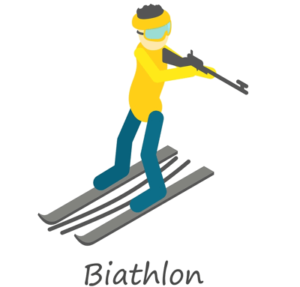 There are a number of shooting events that take place during both Summer and Winter versions of the Olympic Games, such as skeet, air rifle and trap shooting. There are also several different types of skiing events that are common during the Winter Games.
There are a number of shooting events that take place during both Summer and Winter versions of the Olympic Games, such as skeet, air rifle and trap shooting. There are also several different types of skiing events that are common during the Winter Games.
Biathlon is the ultimate test of participants on account of the fact that it puts those two disciplines together, asking competitors to take on a cross-country skiing course as well as numerous stops for shooting.
Usually the competitor with the shortest total time is declared to be the victor, meaning that the sport is something of a race. There are different formats of the biathlon, however, from individual races through to relay variations via mass starts and sprints.
Each of them has their own set of peculiarities and quirks, including how long they last for depending on the gender of the people taking part. The way the events are scored also differ, with some adding time for missed targets, for example. Later, we’ll discuss the different biathlon competitions that exist but for the sake of ease we’ll mainly concentrate on the one from the Winter Olympics.
Best Biathlon Bookmaker
Bet365

Bet365 take winter sports more seriously than most other bookies and that is why they are our recommended site for all skiing formats, including biathon.
Biathlon is a permanent option on the site with ante-post markets available months, even years, in advance of events such as the world cup or the Olympics.
Match-up markets are available closer to event start times. Other decent bookies for Biathlon betting include pretty much any of the super-bookies who have enough traders to cover these types of bets.
How To Bet On Biathlon
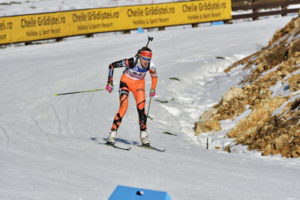 As you might imagine, not all bookmakers offer particularly good markets on biathlon betting. Those that do tend to offer two main markets:
As you might imagine, not all bookmakers offer particularly good markets on biathlon betting. Those that do tend to offer two main markets:
- Athlete versus the field
- Athlete versus athlete
The former asks you to bet on either the athlete you think will win the race or else whether you think someone else in the field will beat them; it’s a little like laying the favourite in a horse race.
The latter, meanwhile, pits two competitors against each other to see which one will do better than the other, regardless of their overall position in the field.
Some bookies will offer you the standard bet on the overall winner of a given event, which is often available ante-post before the event even gets underway. Be careful to make sure you’ve done your research before trying to bet, though, or you might get caught out.
The History Of Biathlon
 According to Scandinavian tradition, the Norse god Ullr was both the god of skiing and the god of hunting.
According to Scandinavian tradition, the Norse god Ullr was both the god of skiing and the god of hunting.
The more romantic types might wish to believe that that is where biathlon finds its origins, when in reality the more likely explanation is that it was borne out of the military training technique that asked prospective soldiers to ski to targets before attempting to shoot them.
The Norwegian Military
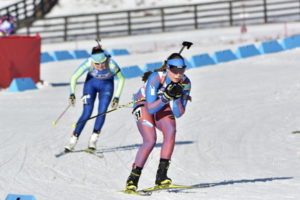 That was the habit of the Norwegian military in the 18th century, with regiments often organising contests that asked competitors to meet one of four different disciplines:
That was the habit of the Norwegian military in the 18th century, with regiments often organising contests that asked competitors to meet one of four different disciplines:
- Skiing at high speed and attempting to hit a mark
- Racing downhill between trees
- Racing downhill without falling
- Racing on the flat wearing skis and carrying a rifle and backpack
From these different disciplines the modern day skiing competitions arose, with the racing downhill gradually becoming slalom racing, as an example. The latter one became cross county-skiing, whilst the former was combined with it to create biathlon competitions.
The first ski club known to have been formed anywhere in the world, Trysil Rifle and Ski Club, was created in 1861 with the specific aim of promoting national defence as a subject at the more local level. As you can tell by the name, it maintained the military discipline of combining skiing and shooting.
The Modern Variants
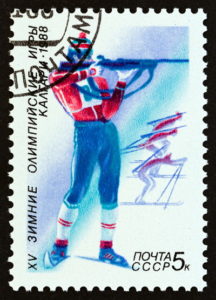 The turn of the 20th century brought with it a number of different variations on much the same theme. One example is Forsvarsrennet, which is a military contest that asks competitors to either travel 17 kilometres cross-country with shooting added to the mix or to race 30 kilometres with marksmanship an important part of the race.
The turn of the 20th century brought with it a number of different variations on much the same theme. One example is Forsvarsrennet, which is a military contest that asks competitors to either travel 17 kilometres cross-country with shooting added to the mix or to race 30 kilometres with marksmanship an important part of the race.
The modern day version of the biathlon is essentially this military exercise altered for a civilian audience. Indeed, until 1984 the biathlon was a branch of Det frivillige Skyttervesen in Norway, which had been set up by the government in order to promote the idea of civilians increasing their marksmanship ability in order to support their national defence.
The Norwegians take the sport seriously, calling it skiskyting, or ski shooting, and promoting separate skifeltskyting contests that require those taking part to race cross-country for 12 kilometres whilst shooting large-calibre rifles at targets with varying and unknown ranges.
The Winter Olympics
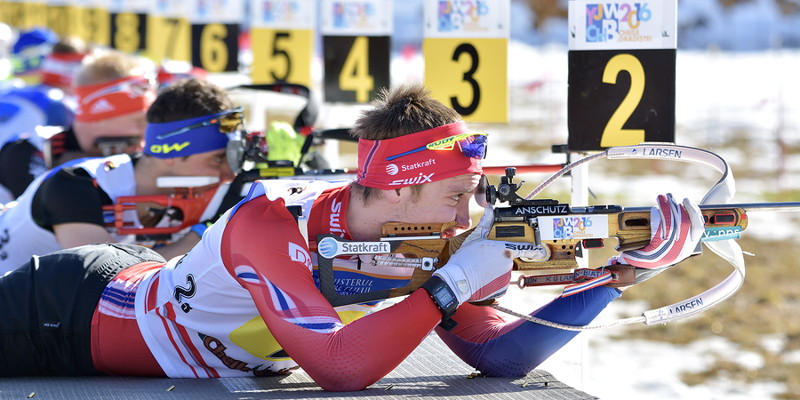
The combination of skiing and shooting as an event at the Winter Olympics was carried out for the first time in 1924 when it was known as Military Patrol. It was then shifted to being a demonstration sport in the two Winter Olympics that occurred before the outbreak of the Second World War and the one in the aftermath of it.
There were only a small number of countries competing in the event at the time and they disagreed on the rules, so it failed to regain Olympic recognition until 1960. Even then it didn’t re-become part of the Winter Olympics out of the blue. Instead the pressure had been mounting for some time, with both Swedish and Soviet winter sports circuits offering biathlon at the time.
The sport was popular with the watching public, with this popularity aiding the cause of those pushing the Olympics to look again at Biathlon as a sport. It was arguably the 1958 hosting of the Biathlon World Championships by Austria that forced the hands of the International Olympic Committee, given that they could no longer point towards a lack of agreement on the sport’s rules as the reason to exclude it. Remarkably it still took the IOC 32 years to allow women to compete in biathlon at the Olympics.
Changes To The Competition
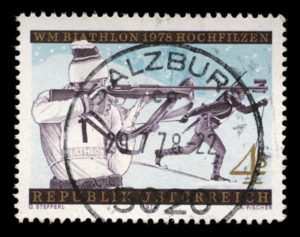 Between 1958 and 1965 biathlon competitions saw the use of high-powered centre fire cartridges like the Springfield .30-06 and the NATO 7.62×51mm. That continued until 1978 when it was decided to standardise the calibre of cartridge used to the .22 Long Rifle rimfire.
Between 1958 and 1965 biathlon competitions saw the use of high-powered centre fire cartridges like the Springfield .30-06 and the NATO 7.62×51mm. That continued until 1978 when it was decided to standardise the calibre of cartridge used to the .22 Long Rifle rimfire.
1978 was also the year that the shooting range was reduced down to 50 metres, having previously stood at 100 metres, 150 metres, 200 metres and 250 metres before being standardised to 150 metres with the introduction of the relay aspect to the event in 1966.
1980 was the year that mechanical, self-indicating targets were used for the first time in the Olympic Games. It happened at the Winter Olympics hosted at Lake Placid in New York. It took close to 40 years for fully electronic targets to be approved for use, with International Biathlon Union events allowing them from the 2018-2019 season onwards. It meant that they could be used as an alternative to either the paper or mechanical steel targets that had been in use in IBU events up to that point.
The International Biathlon Union
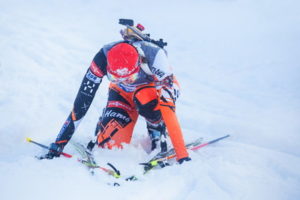 In 1948 the Union Internationale de Pentathlon Moderne was founded with the aim of standardising the rules use for pentathlon events. In 1953 it was decided that biathlon would also come under the Union’s remit, with the UIPMB remaining in charge of the organisation and standardisation of biathlon events for 40 years.
In 1948 the Union Internationale de Pentathlon Moderne was founded with the aim of standardising the rules use for pentathlon events. In 1953 it was decided that biathlon would also come under the Union’s remit, with the UIPMB remaining in charge of the organisation and standardisation of biathlon events for 40 years.
That was until 1993 when the International Biathlon Union was created as an offshoot of the Union Internationale de Pentathlon Moderne specially concentrating on biathlon as an event.
The decision was taken because of the National Biathlon Union’s decision to exclude biathlon from the World Federation for the first time, with the 57 existing members of the UIPMB simply shifting across to the IBU.
Even so, the the IOC refused to acknowledge this new organisation as being official until 1998, which was also the same moment that the Global Association of International Sports Federations declared the IBU to be an official member. The organisation has grown ever since, moving to Salzburg in Austria in 1999 and hosting a congress every two years.
Biathlon Rules
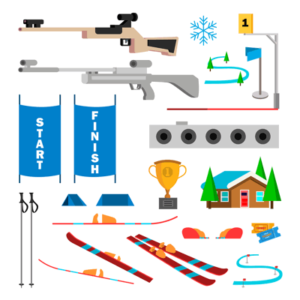 The basic idea behind biathlon is that contestants will ski cross-country through a trial system that had a distance divided into either 2 or 4 shooting sections.
The basic idea behind biathlon is that contestants will ski cross-country through a trial system that had a distance divided into either 2 or 4 shooting sections.
One half of these sections will be taken on standing and the other from a prone position. The performance of the shooter will see time either added to or taken away from their total skiing and distance time and the person with the shortest time wins.
There are five targets that need to be struck at each shooting station, with competitors either having a minute added to their total time or else being required to ski a 150 metre loop as a penalty. Usually a penalty loop needs to be completed for each target that is still standing at the end of the shooting section, with a maximum of three extra cartridges being available on each round.
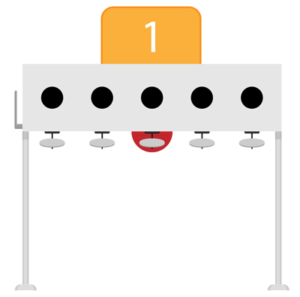 Large screens are usually placed around the course that will display the split times for the skiing and shooting sections of the race. This is so that viewers can have an idea of which competitor is in the lead at any given moment.
Large screens are usually placed around the course that will display the split times for the skiing and shooting sections of the race. This is so that viewers can have an idea of which competitor is in the lead at any given moment.
When it comes to the skiing, the Winter Olympics allows competitors to use any cross-country skiing technique available, with the majority of competitors usually opting to employ skate skiing. The skis used must be the height of the skier minus 4 centimetres. The rifle also needs to be carried at all times.
The rifles must weigh at least 3.5 kilograms without magazines and ammunition. The magazines can carry 5 rounds each and competitors can take 4 of them. The only exception to this is on relay races when additional rounds can be carried. The target’s diameter is 45 millimetres when competitors are in the prone position and increases to 115 millimetres for the standing position. The will be black until they are hit, at which point they’ll become white.
Different Biathlon Formats
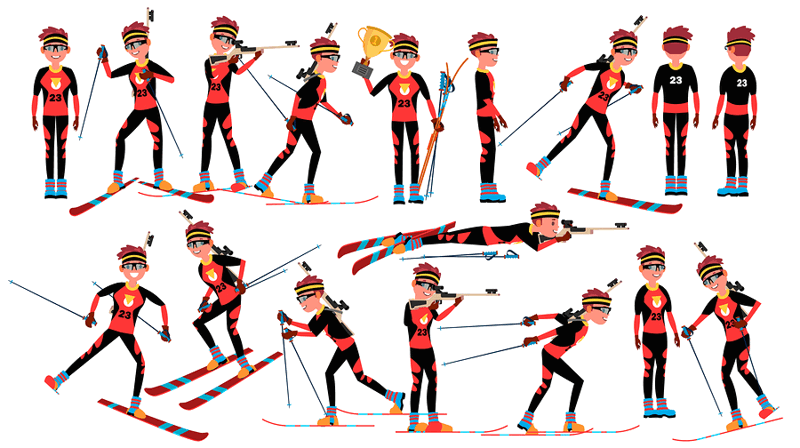
There are eight variations to biathlon as a sport, which we’ll look at in more detail here:
Individual Biathlon
Men race over 20 kilometres and women 15, with the distance being skied over five laps. Competitors need to shoot four times at any shooting lane, with the order being prone, standing, prone standing. They need to hit 20 targets in total and for each miss they get a time penalty. The starts of the competitors are staggered by a time of around 30 seconds.
In the 2018-2019 season a variation called Short Individual was added to the Biathlon IBU Cup, requiring men to travel 15 kilometres and women 12.5, with a missed target resulting in a 45 second penalty.
Sprint
Men travel 10 kilometres and women 7.5, with the distance requiring three laps to be skied to completed it. Those taking part shoot once in the prone position and once standing. They have to shoot ten times and ski a penalty loop of 150 metres for each miss.
Super Sprint
This variation on the event has only been around since the 2017-2018 season and is a short version of the Sprint. Super Sprint involves a qualification and then final phase, with qualification carried out like the traditional Sprint but over a total length of 2 kilometres. The top 30 then make it into the final.
The final of the Super Sprint sees all competitors start at the same time and do 5 laps of the course for a total of 5 kilometres. Competitors are allowed a spare round but if they fail to clear a target there is no penalty lap, they’re simply disqualified.
Pursuit
Competitors’ start times are separated according to their times in a previous event, with men then racing 12.5 kilometres and women 10. They have to do five laps of the course, with four shooting sections done in the order of prone, prone, standing, standing. A miss requires participants to do a 150 metre penalty. The winner is the person that crosses the finishing line first.
Mass Start
This is similar to pursuit in the sense that the first person to cross the line is the winner and the competitors need to do five laps of the circuit and do four shooting stations in the prone, prone, standing, standing order. The difference comes in both the length of the race, which is 15 kilometres for men and 12.5 for women, as well as in the fact that everyone starts at the same time.
The first shooting section sees those taking part shooting from the lane that matches their bib number, but the rest are dealt with on a first-come, first-served basis. Each miss involves a 150 metre penalty loop.
Mass Start 60
The Mass Start 60 was introduced as an event for the 2018-2019 season and is essentially the same as the Mass Start, with the exception being that 60 people can take part rather than 30.
The big difference is that everyone starts the race but the first 30 stop to shoot at the end of the first lap whilst the other 30 keep skiing. They then swap over on the second lap. The first shoot is prone, with the remaining ones being one prone and two standing.
Relay
Four competitors are in each team and each one of them skis 7.5 kilometres if they’re a man and 6 kilometres if they’re a woman. Each leg involves three laps and two shooting rounds. Each round offers five targets and eight bullets.
A 150 metre penalty loop is then skied for each target missed. Each participant must touch their team mate for the changeover to be valid.
Mixed Relay
The final version of the race to tell you about is similar to normal Relay but with mixed-gender teams. The first two legs are done over 6 kilometres by the women and the next to by men over 7.5 kilometres.
Major Competitions
| Competition | Details |
|---|---|
| Biathlon at the Winter Olympics | Biathlon has been a Winter Olympic sport since 1960 and involves individual, relay, sprint, pursuit and mass start for both genders, plus a mixed relay |
| Biathlon World Cup | Inaugurated in 1977 for men and 1986 for women, the Biathlon World Cup season usually goes from November to March and the athlete with the highest score wins |
| IBU Cup | Organised by the IBU, this competition first took place in 1982 for men and 1988 for women. As with the World Cup it usually lasts for several months and the highest scoring competitor overall is the winner |
As you can imagine, the world of the biathlon has many interesting competitions to offer, though the Olympics is the most famous and prestigious of them all. Above we take a quick look at the biggest ones.
